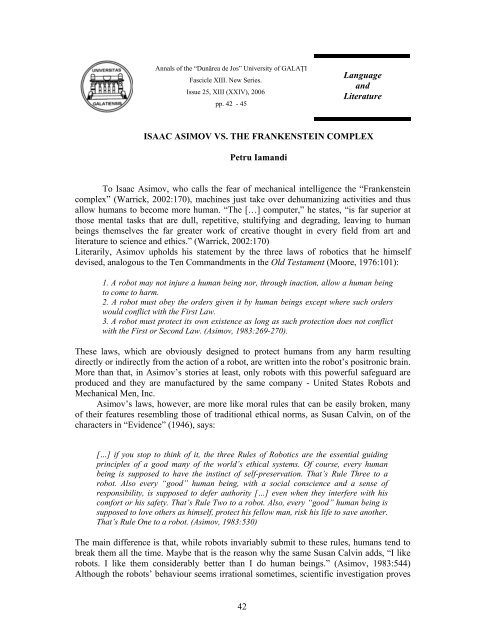PDF. - full text
PDF. - full text
PDF. - full text
You also want an ePaper? Increase the reach of your titles
YUMPU automatically turns print PDFs into web optimized ePapers that Google loves.
Annals of the “Dunărea de Jos” University of GALAŢI<br />
Fascicle XIII. New Series.<br />
Issue 25, XIII (XXIV), 2006<br />
pp. 42 - 45<br />
42<br />
Language<br />
and<br />
Literature<br />
ISAAC ASIMOV VS. THE FRANKENSTEIN COMPLEX<br />
Petru Iamandi<br />
To Isaac Asimov, who calls the fear of mechanical intelligence the “Frankenstein<br />
complex” (Warrick, 2002:170), machines just take over dehumanizing activities and thus<br />
allow humans to become more human. “The […] computer,” he states, “is far superior at<br />
those mental tasks that are dull, repetitive, stultifying and degrading, leaving to human<br />
beings themselves the far greater work of creative thought in every field from art and<br />
literature to science and ethics.” (Warrick, 2002:170)<br />
Literarily, Asimov upholds his statement by the three laws of robotics that he himself<br />
devised, analogous to the Ten Commandments in the Old Testament (Moore, 1976:101):<br />
1. A robot may not injure a human being nor, through inaction, allow a human being<br />
to come to harm.<br />
2. A robot must obey the orders given it by human beings except where such orders<br />
would conflict with the First Law.<br />
3. A robot must protect its own existence as long as such protection does not conflict<br />
with the First or Second Law. (Asimov, 1983:269-270).<br />
These laws, which are obviously designed to protect humans from any harm resulting<br />
directly or indirectly from the action of a robot, are written into the robot’s positronic brain.<br />
More than that, in Asimov’s stories at least, only robots with this powerful safeguard are<br />
produced and they are manufactured by the same company - United States Robots and<br />
Mechanical Men, Inc.<br />
Asimov’s laws, however, are more like moral rules that can be easily broken, many<br />
of their features resembling those of traditional ethical norms, as Susan Calvin, on of the<br />
characters in “Evidence” (1946), says:<br />
[…] if you stop to think of it, the three Rules of Robotics are the essential guiding<br />
principles of a good many of the world’s ethical systems. Of course, every human<br />
being is supposed to have the instinct of self-preservation. That’s Rule Three to a<br />
robot. Also every “good” human being, with a social conscience and a sense of<br />
responsibility, is supposed to defer authority […] even when they interfere with his<br />
comfort or his safety. That’s Rule Two to a robot. Also, every “good” human being is<br />
supposed to love others as himself, protect his fellow man, risk his life to save another.<br />
That’s Rule One to a robot. (Asimov, 1983:530)<br />
The main difference is that, while robots invariably submit to these rules, humans tend to<br />
break them all the time. Maybe that is the reason why the same Susan Calvin adds, “I like<br />
robots. I like them considerably better than I do human beings.” (Asimov, 1983:544)<br />
Although the robots’ behaviour seems irrational sometimes, scientific investigation proves












